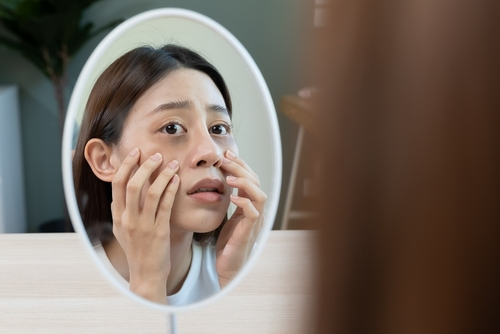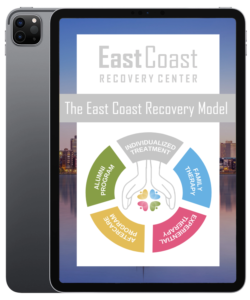If you’ve heard the term coke bloat, you might think of a bloated stomach after drinking too much soda or eating a large meal. You’ll be surprised to learn that coke bloat refers to two strange but somewhat common side effects of cocaine abuse.
This article explains everything you need to know about coke bloat, including its causes, how to get rid of it, and ways to treat a cocaine addiction that may lead to it.
If you or a loved one are struggling with cocaine abuse, East Coast Recovery Center can help. We offer outpatient cocaine addiction treatment programs that can help you break the cycle of addiction, including day treatment and partial day treatment programs in the Boston area.

What Is Coke Bloat?
Coke bloat refers to facial puffiness or abdominal bloating as a result of snorting, smoking, or injecting powder or crack cocaine. Most people are used to visual signs of cocaine use, such as white residue near the nose, dilated pupils, excessive lip or tongue movement, and teeth grinding. But because of cocaine’s appetite-suppressing effects, a puffy face or enlarged stomach can appear more prominently if a user hasn’t been eating as much during a cocaine binge.
Facial coke bloat is usually predominant near the cheeks and under the chin, while abdominal coke bloat is most noticeable in the belly and feels tight, swollen, or full of gas. This is quite the opposite of how cocaine users are portrayed on film or television as thin, pale, or sickly. Reports have found that coke bloat and other gastrointestinal issues from cocaine abuse can appear within one to 48 hours after use. This could make it harder to miss.
Connect With Us Now
Reach out to us now for immediate support, or let us know the best time to contact you through our confidential callback service. Your journey to healing is just a conversation away.
What Causes Coke Bloat?
Facial coke bloat or puffiness can be caused by:
- Fluid retention: Cocaine can cause blood vessels in the face to constrict, which prevents lymphatic fluid from recirculating back into the bloodstream. This fluid can build up in the shrunken vessels and cause the face to swell. Overnight fluid retention is typically normal but can be disrupted by too much or too little sleep, and falling asleep after a long cocaine binge can further exacerbate morning facial swelling.
- Snorting: Snorting cocaine can irritate and inflame the nasal passage and sinonasal mucosa, leading to facial puffiness and potential destruction of nasal, palatal, and pharyngeal tissues.
Abdominal coke bloat can be caused by:
- Peritonitis: Constricted blood vessels can cause peritonitis, inflammation of the membrane lining the abdominal wall and covering the abdominal organs. This can be life-threatening if left untreated.
- Intestinal ischemia: Narrowed blood vessels can reduce the amount of blood reaching the small intestines, leading to bloating, cramps, abdominal pain, nausea, and vomiting.
- Additives: Cocaine sold on the street is usually never 100% pure and is diluted with adulterants, including caffeine, baby powder, and levamisole. Snorting or injecting caffeine or baby powder can clog blood vessels, and levamisole (dewormer) can cause abdominal pain. Levamisole can also cause the parotid glands in front of the ears to swell and contribute to puffiness.
- Dehydration: Cocaine’s stimulant effects can make it easy to forget to eat or drink water, which can lead to abdominal bloating.

Is Coke Bloat Dangerous?
While facial puffiness and occasional bloating aren’t serious medical conditions, experiencing frequent and consistent coke bloat probably accompanies other side effects, including addiction. You might experience fatigue, joint pain, chest pain, and swelling in your legs, ankles, and feet. Cocaine use can also damage your respiratory system, especially when smoked or injected, causing breathing issues, coughing, wheezing, hemoptysis (coughing up blood), pulmonary edema, and pulmonary hemorrhaging.
If your stomach is bloated long after you’ve stopped using cocaine, gets progressively worse, becomes painful, or accompanies other symptoms such as fever, vomiting, or bleeding, seek immediate medical attention.
Read more: Why You Should Avoid Fish Scale Coke
Take Our Addiction Quiz For Recovery Insights
How To Get Rid Of Coke Bloat
Here are the most common ways to get rid of facial and abdominal coke bloat.
- Facial bloating: Some of the most encouraged ways to reduce facial swelling or puffiness are by applying hydrocortisone to relieve swelling or inflammation and using a derma roller to massage puffy areas. You can also apply a cooling mask or cold compress to your face or take a cold shower.
- Abdominal bloating: Some of the best ways to relieve abdominal bloating include taking a walk to stimulate intestinal movement, slowly breathing from the diaphragm, holding a Child’s Pose yoga position for 8 to 10 deep breaths, applying a warm compress on your belly, gently massaging your stomach, drinking hot chamomile or ginger tea, and taking peppermint oil capsules. If none of these seem to work, look into over-the-counter medications or talk to your primary physician, who can recommend you to a gastroenterologist.

How To Treat Cocaine Addiction
Facial and abdominal coke bloat are not the only side effects of cocaine use. As mentioned earlier, cocaine abuse can lead to organ damage, weight loss, malnutrition, stroke, seizure, and much more. It takes a lot of confidence and bravery to mentally and verbally admit you have a cocaine addiction, but calling and signing up with an addiction treatment center can be another challenge, especially when you’re not sure what to expect. To help, here are a few of the most common addiction treatment options for cocaine abuse.
- Residential programs: These addiction treatment programs provide 24-hour medical care and monitoring and have the highest level of structure. This is the best option for individuals who’ve never gone to addiction treatment and have a severe substance use disorder.
- Day Treatment Program: Partial hospitalization programs are a step down from residential treatment. Clients attend treatment 30 to 40 hours a week but can return home at the end of each day. Some Day Treatment Program programs have nearby sober living facilities so clients can attend treatment but also come home to a personalized and safe living environment.
- Partial Day Treatment Program: Intensive outpatient programs are less intensive, and clients usually attend treatment for 20 to 30 hours a week and return home at the end of the day. This is the best option for individuals who don’t require 24-hour care but want to reinforce and practice recovery skills at home.
Are You Covered For Treatment?
East Coast Recovery Center partners with numerous private insurance providers. Our team is committed to assisting you in quickly and effortlessly verifying your insurance coverage for treatment.
Cocaine Addiction Treatment In Boston, MA
If you or someone you know is experiencing coke bloat, now’s the time to call East Coast Recovery Center in Boston, MA. Our addiction treatment center is the perfect place to overcome unhealthy and life-changing substance use disorders. We offer 24/7 admissions, complimentary transportation to and from our center, and work with most major healthcare plans. Don’t wait. Call today, and one of our admissions agents can help you get started or answer any preliminary questions about insurance, intake, or scheduling.










